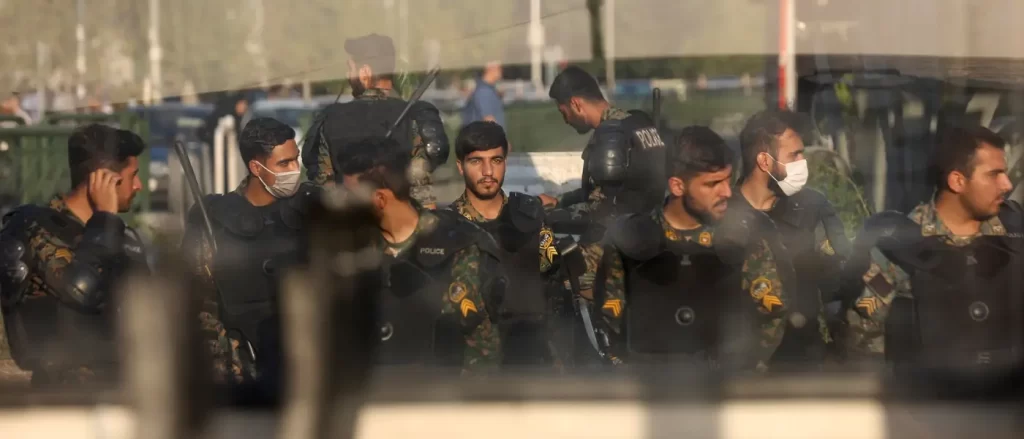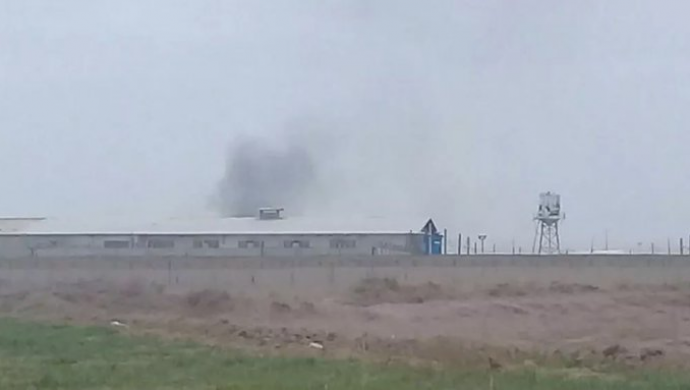https://twitter.com/1MedyaNews/status/1703437907737092461
The anniversary of Jîna Mahsa Amini’s death, that catalyst for mass anti-regime protests in Iran, was marked by pre-emptive security measures by the Iranian government, widespread mass protests despite the heavy presence of said forces, and reports of prison unrest.
Heavy security deployment
On the eve of the anniversary, people in Tehran and many other cities across the country began working up to protests by chanting slogans from their windows.
However, the Iranian security forces, including the Islamic Revolutionary Guard Corps, were strategically stationed in various cities from the early hours of Saturday in anticipation of such protests. This was particularly the case in the Kurdish-majority regions known as Rojhilat in western Iran and in major cities such as Tehran, Karaj, Rasht and Tabriz.
The centres of the cities were full of heavy military and various other security forces, including many undercover agents. Military vehicles equipped for riot control were strategically positioned in certain areas, and black marias were in place to lock up potential detainees. Security forces had used vehicles to completely cordon off certain neighbourhoods, such as Ekbatan in Tehran, where access to main roads is limited, and maintained a constant presence.
A retired member of the Revolutionary Guard who fought in the Iran-Iraq war posted on his social media account, “I don’t exaggerate when I say that if a foreign country had occupied Tehran and Iran, they couldn’t have deployed as many forces on the streets to prove that your country is occupied”, according to Iran International.

Kurdish-majority cities blockaded
Stringent checkpoint inspections and comprehensive searches of both passengers and vehicles were implemented at the entrances and exits of all cities with a significant Kurdish population, causing serious traffic congestion.
Security forces blocked the road between the Kurdish cities of Baneh and Saqqez, Jîna Amini’s home city, to restrict the movement of people.
It appears from online video footage that the authorities opened a sluice in the Saqqez dam, increasing the water level in the dried-up river next to the graveyard where Jîna Amini is buried, to block protesters’ access to the grave. Security forces had sealed off the main entrance to the cemetery on Friday.
Father of Jîna Amini under house arrest
The security forces also detained Jîna’s father, Amjad Amini, as he left his home on Saturday morning, in an attempt to prevent the commemoration. He was later placed under house arrest. The area around Amini’s home remained under lockdown throughout the day.
In an attempt to justify the house arrest, the state-run IRNA news agency reported that there had been an alleged assassination attempt against Amjad Amini as he was en route to his daughter’s grave. “Security forces arrested several members of a terrorist group who intended to assassinate Amjad Amini”, the news agency stated, citing the deputy governor of Kurdistan province, Mehdi Ramezani.
Kurdistan province workers strike amid security clampdown
Workers and businesses in at least 18 cities across Kurdistan province of Iran embarked on a massive strike to mark a year on from the beginning of the “Jin, Jiyan, Azadî (Woman, Life, Freedom)” movement. The strike was organised in response to a call from Kurdish political parties and organisations.
Cities across Iran, including the Kurdish city of Sanandaj, strike on the anniversary of Mahsa Jina Amini’s tragic murder. Shops are shuttered in protest against the Islamic regime that silenced innocent Mahsa. A powerful message to the regime: They’re not wanted here.… pic.twitter.com/9Tuafuz86G
— Masih Alinejad 🏳️ (@AlinejadMasih) September 16, 2023
Despite the peaceful nature of the strike, reports indicated that a significant deployment of repressive forces, including snipers and special units, were dispatched to the relevant locations.
These security forces were seen patrolling the cities and, in some instances, creating an atmosphere of intimidation, particularly in Saqqez. Adding to the tension, helicopters operated by the Revolutionary Guard were observed flying at low altitudes over several cities.
Day of confrontation
Pockets of protest were reported across the country throughout the day, in defiance of the ominous presence of security agents who quickly dispersed any gatherings that resembled the beginnings of demonstrations. As the day progressed, however, citizens poured into the streets to voice their grievances against the regime.
By midday, clashes had broken out between groups of demonstrators and security forces.
These confrontations took place in the capital, Tehran, as well as in cities such as Rasht and Mashhad, which Iranian President Ebrahim Raisi had visited earlier in the day.
A video on social media showed that reinforcements were unable to reach the square in Mashhad due to the crowds of protesters.
Throughout the day, there were widespread reports of protesters being arrested across the country. The internet was also cut off in some regions.
As the night wore on, protests and clashes intensified in several cities across the country. Crowds of protesters chanted “Death to the Dictator” and “Jin Jiyan Azadî” throughout the night.
Today in Sanandaj, Iran
People gathered on Mahsa’s day chanting death to Khamenei! #IRGCterrorists #MahsaAmini pic.twitter.com/g5y0uLw9VA
— Maryam Banihashemi (@MaryBanihashemi) September 16, 2023
There were reports of gunfire on demonstrators in Tehran and the Kurdish-majority cities of Kermanshah and Sanandaj. However, it was not possible to confirm any casualties or to give any further details regarding the shootings.
Videos obtained by @IranIntl show security forces are shooting at protesters in the city of Kermanshah in western Iran on the anniversary of Mahsa Amini’s death in custody.
In one video, a person is heard saying that someone has been shot. pic.twitter.com/YAFQ4iqEGZ— Iran International English (@IranIntl_En) September 16, 2023
Revolutionary Guard shooting leaves worker with special needs in critical condition
Revolutionary Guard forces shot at 28-year-old Fardin Jafari in Saqqez. Jafari, a construction worker with a diagnosis of special needs, is in a critical condition in intensive care. According to reports from the Norway-based human rights group Hengaw, he was returning from a daily shopping trip when he encountered large numbers of armed forces, and being afraid, started to run, and the security forces shot at him because he was running away.
Protests and fire in women’s prisons
A fire broke out around midnight in Qarchak Prison near Tehran, where female inmates had been protesting throughout the day in support of the Jin Jiyan Azadî movement.
Thick smoke was seen rising from the prison in the early hours of Sunday morning, but the condition of the prisoners is still unknown at the time of reporting. The prison telephones were reportedly cut off and citizens have been unable to get news from the prisoners due to the distance of the prison from the city centre.

Iranian state media claimed that female inmates on death row had set fire to the women’s ward in the prison by burning their clothes, but, earlier in the day, a Kurdish human rights group reported that special forces had entered wards where the women were protesting, assaulting the women and firing airgun pellets at some of the protesters.
Meanwhile, detainees in the women’s wing of Tehran’s Evin Prison staged their own protest, chanting slogans against the regime, refusing to enter their cells, and setting fire to their headscarves within the prison courtyard.










